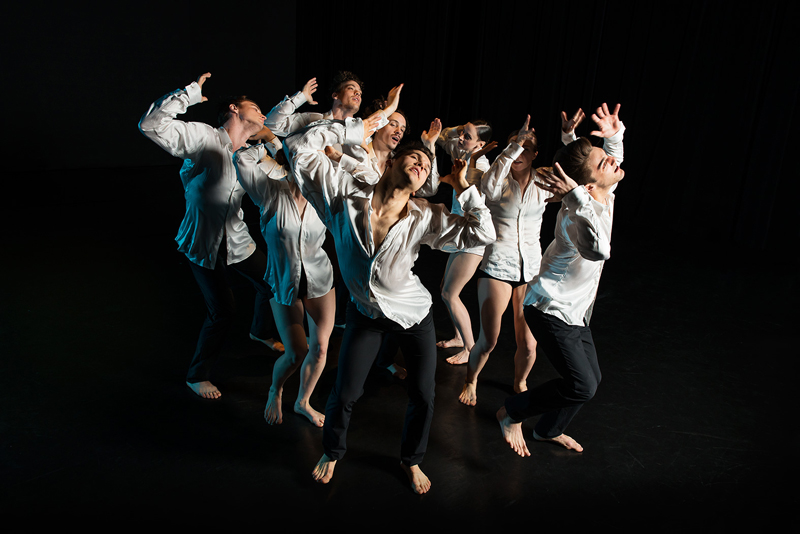Cas Public: Hélène Blackburn / Symphonie Dramatique - Vancouver Ballet Society
- Home
- Reviews 2014 - 2019
- Cas Public: Hélène Blackburn / Symphonie Dramatique

by Steve Sucato
Few tales are as universally known and beloved as Shakespeare’s Romeo and Juliet. Countless dance versions have been created, approaching the story of two star-crossed lovers from numerous angles. For choreographer Hélène Blackburn and her Montreal-based company Cas Public, Romeo and Juliet took on a broader meaning. In Blackburn’s Symphonie dramatique, the main characters are representative of needs found in all of us for love, acceptance and happiness.
Founded in 1989 by Blackburn, Cas Public has built a reputation in Canada and abroad as a forward-thinking contemporary dance company. That way forward took a slight detour in 2001 when Blackburn turned the company’s focus toward creating dance works suitable for young audiences. Symphonie dramatique, premiered in 2014 and titled after Hector Berlioz’s score based on Romeo and Juliet, is one of those works. The U.S. premiere at Pittsburgh’s Hillman Center for Performing Arts this past November was indeed suitable for young audiences, but perhaps more in the sense that a Dali or Picasso painting might be to a young mind — wondrous, but needing some explanation to fully grasp. The hour-long multimedia production, dense with beautifully crafted movement performed with deft skill by Cas Public’s eight dancers, spoke to both novice and seasoned dancegoers.
Set to an original soundscape by Martin Tétreault that sampled music from Prokofiev, Tchaikovsky, Gounod and others, the abstract contemporary dance-theatre work opened on a barely lit stage devoid of side curtains with eight microphones on stands lined up horizontally across it. Looming over them was a large chandelier made from clear plastic goblets.
One of many uses of symbolism in the work, the dancers approached the microphones as a means to introduce Shakespeare’s story to the audience. But only dancer Marc-André Poliquin, the works de facto narrator, spoke. Poliquin’s thick French-Canadian accent lent an edge to his impassioned recitation of Shakespeare’s words, which were also projected on a screen at the rear of the stage. Although the narration and text projections were helpful in the setting of several of Symphonie dramatique’s scenes, prior knowledge of Romeo and Juliet seemed presumed to make sense of the work.
Blackburn’s choreography (in collaboration with the dancers) was a mix of contemporary dance and hip-hop styles. Articulated hand and arm movements, torso isolations and various gestures by the dancers to Tétreault’s surreal-sounding music, along with Poliquin’s poetic interjections, created an overall mood for each scene rather than precisely following Shakespeare’s narrative.
The recurring theme of the Romeo and Juliet characters as representative ideas was driven home in the way that Romeo, Juliet and other characters were seen in multiples, sometimes even costumed in T-shirts with “Romeo” or “Juliet” inscribed on the back of them. Like echoes, a central pair of dancers portraying the two lovers in a scene would be joined by one or two other pairs mimicking their movements.
Of the work’s many bright spots, the most technically challenging and captivating to watch were several rapid-fire, turn-on-a-dime, male/female pas de deux à la Édouard Lock of La La La Human Steps fame. Cas Public’s stellar trio of female dancers, Roxane Duschene-Roy, Daphnée Laurendeau and IsaBelle Pacquette, were spun on pointe like tops, legs a whir of taut muscles and elegant lines, by their partners. Of particular note was a pas de deux by Alexandre Carlos and Paquette in which the statuesque Paquette was folded over, twisted, turned and lifted, spellbinding the audience with her grace and power.
Other memorable moments included: a humorous fit in which Poliquin rolled on the floor, screeching like a velociraptor; a lively section entitled Interlude: Folk Dance, in which the dancers in a cluster punched at the air in front of them, then waved their hands violently at the sides of their heads and gyrated like go-go dancers; and a scene depicting the death of Mercutio at the hands of Tybalt, where Poliquin, in the midst of an intense soliloquy, repeatedly lifted up a lifeless Mercutio (Cai Glover) and bounced him off the floor like a basketball.
In one scene, a trio of Juliets and Romeos pretended to make out. Seated on benches, they moved through hunched embraces, rocking head motions and lustful entanglements. Symphonie dramatique concluded with the cast falling to the stage floor as the overhead chandelier came crashing down with a roar.
A far cry from conventional Romeo and Juliet ballets, Symphonie dramatique was a triumph. The work’s blend of avant-garde theatricality, top-notch choreography and solid dancing was most satisfying and elicited a well-deserved standing ovation from the Hillman Center audience.
DI SPRING 2016

